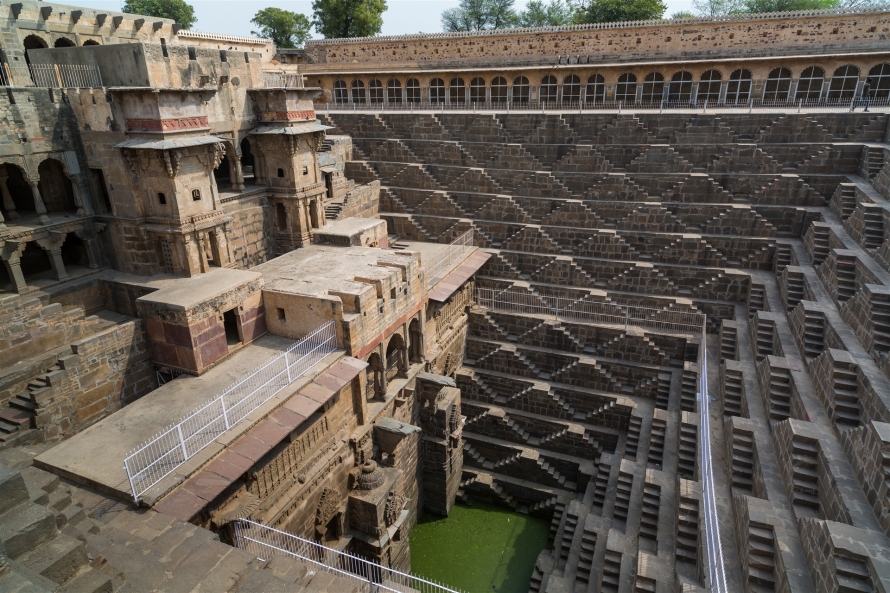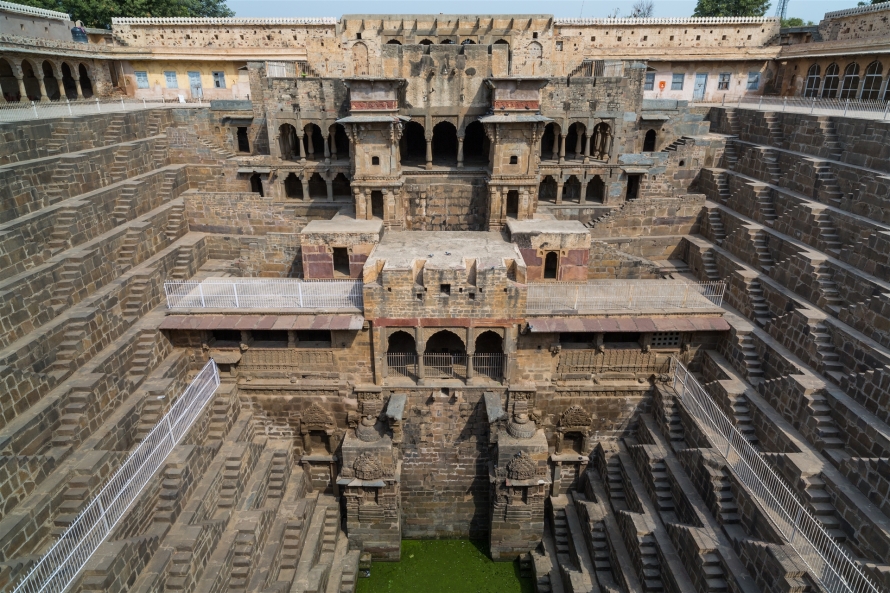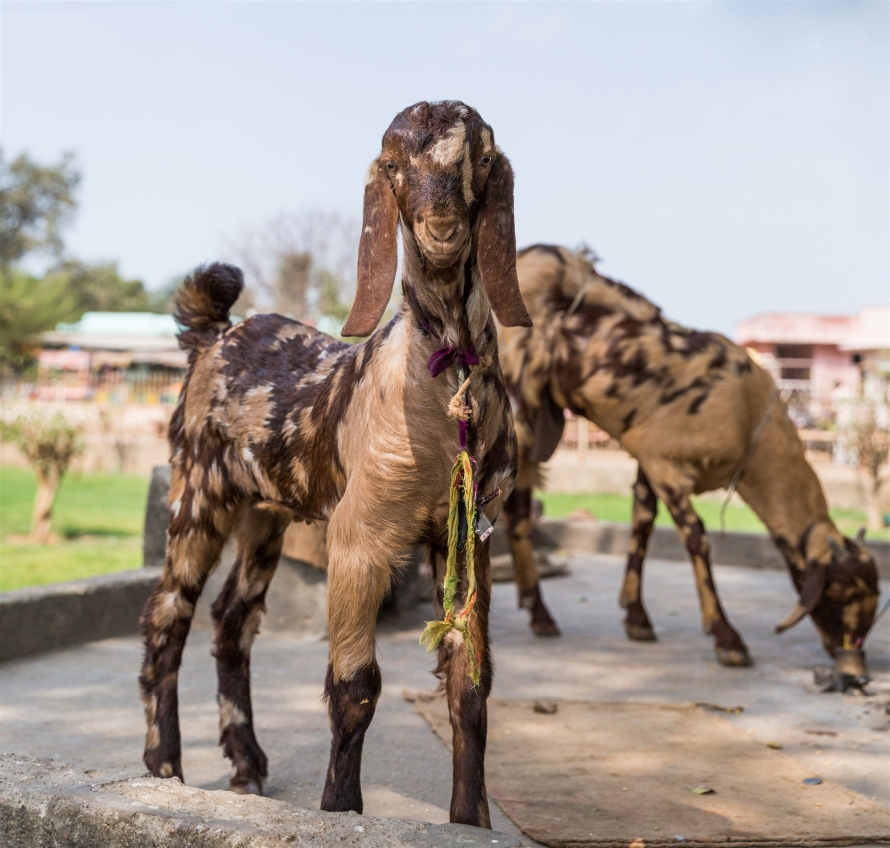If your Jaipur itinerary can afford a day excursion and you’re looking for somewhere that does not mean you’re stuck in the car for a large proportion of the day, then Abhaneri is the place to head for. Abhaneri is just 95km from Jaipur on the Jaipuir-Agra road, the road is in great condition so it only takes about 90 minutes to get there.
As you arrive you may be wondering quite what’s in store for you, Abhaneri is a tiny village which on the surface has nothing of any significant note, other than a great opportunity to observe local rural life. But soon you will see why this tiny village holds so much attraction.
Abhaneri is famous for two landmarks, the Chand Baori and Hasat Mata Temple.
The Chand Baori is one of the oldest attractions in Rajasthan and was built by King Chanda of the Nikumbha Dynasty between 800 and 900 A.D. It was dedicated to Hashat Mata, Goddess of Joy and Happiness, for which there is a reconstructed temple right next door (more on that shortly…).
Being an extremely arid region, as indeed most of Rajasthan is, the step-well was intended to conserve as much water as possible. 3,500 narrow steps over 13 stories lead down 100ft into the ground making this one of the largest and deepest step-wells in the whole of India. And it works, the step-well never dries up and the temperature at the bottom is always 5-6 degrees cooler than at the surface.
This was a gathering place for locals during periods of intense head, also housing a pavilion and resting room on one side specifically for royalty.

When I visited the site was largely deserted, which is quite perplexing considering it’s a very short distance from the main Jaipur-Agra road, the main thoroughfare for those on their “golden triangle” tourist venture. On my first visit to India 10 years ago I did that very same trip and our coach party must have passed by with the occupants blissfully unaware of what resided just outside the window. It’s a great shame that most tour companies seem to omit this from such an itinerary, but equally I’m glad they do as the peaceful ambiance is retained and you feel like you have the place largely to yourself.
Whilst I was there some major conservation work was being undertaken on the outer perimeter wall, mostly by local women who were working tirelessly in the midday sun transporting mortar from outside the step-well to the interior.
Whilst there, take some time to admire the fragments of sculpture that sit around the outer edge of the interior of the site. These have been taken from the remains of the nearby and now rebuilt Hashat Mata temple. The crispness and detail of the work is staggering, although you need to get down on your knees to truly admire the craftsmanship.
There is one minor scam you should be aware of. On leaving you will be invited to sign a guestbook, and then asked to make a donation. This is operated purely by the locals and is not associated with the ASI at all. Just politely decline, there are numerous comments on other travel sites about this and people getting quite irate over the situation, but it’s not aggressive in nature so didn’t bother me particularly.
Having visited the step-well, turn left, cross the minor road, and enter the Hashat Mata Temple.
It’s believed this temple was also built by Kind Chanda at about the same time as the step-well, but was later destroyed by the islamic invasions. What remains today is a rather randomly rebuilt temple structure using stone from the ruins, along with fragments of stone carvings that have been excavated out of the ground and lined up around the temple perimeter. Some are numbered, almost giving a hint that some massive reconstruction is about to happen at any moment, but I suspect that is not the case.
Take time to walk among the fragments of sculpture at your feet, the quality and freshness of the carvings clearly indicates these stones must have been buried at some point, and for a very long time. There is hardly any sign of erosion, they look as pristine as the day they were crafted.

It’s also well worth a quick explore of the village itself if you have time.
The Abhaneri sites are open sunrise to sunset.
If you’re interested in using any of my photography or articles please get in touch. I’m also available for any freelance work worldwide, my duffel bag is always packed ready to go…
KevinStandage1@googlemail.com
Categories: Abhaneri : Chand Baori, India, Jaipur, Rajasthan


























Reblogged this on Kevin Standage.
LikeLike
great work sir
LikeLiked by 1 person
Thanks !
LikeLike
Wonderful! Love it Kevin, both your pictures and the text. Thank you.
LikeLiked by 1 person
Thanks for your comment !
LikeLike
Wonderful!
LikeLiked by 1 person
Thanks !
LikeLike
Fantastic photography! I wish I’d known about you before our last trip, as your information is helpful. We did visit this step well, and like you, I found it extremely interesting. I was sorry we had just a short time to explore.
LikeLiked by 1 person
India warrants a lot of time, its such a huge and diverse country ! I’m in the midst of planning my 20th visit to the country, and even now the list of places I want to visit is getting larger rather than smaller ! Thanks for stopping by.
LikeLiked by 1 person
I can imagine that’s true…the more we know, the more we want to know more! How do you deal with the sanitation issue? Most of our group got pretty serious diarrhea. Do you take anything prophylactically to prevent trouble?
LikeLiked by 1 person
Believe it or not I’ve never had an issue in India. I’m reasonably careful in where I choose to eat (but always it’s indian food!), drink bottled water only and that’s about it. I eat quite a lot of spicy asian food when I’m back in the UK so maybe I’m just acclimatised better before I go 🙂
LikeLiked by 1 person
Hi Kevin, there wasa talk today on the Chand Baori on the Allchin Symposium. I know they were recording the event, so if you are interested it should appear on the India & Iran Trust website in due course. Decided to have a look through your old blogs for better photos and was rewarded. Thanks for sharing all your wonderful pics.
LikeLiked by 1 person
Thanks – the older blogs aren’t quite up to my more recent efforts ! I will be on the lookout for the talks, thanks so much for the pointers
LikeLike